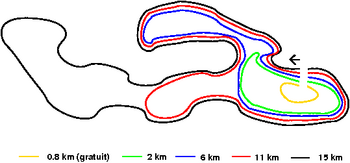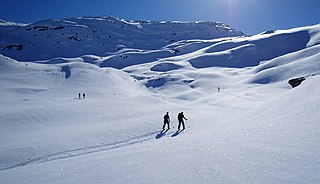
Cross-country skiing is a form of skiing whereby skiers traverse snow-covered terrain without use of ski lifts or other assistance. Cross-country skiing is widely practiced as a sport and recreational activity; however, some still use it as a means of transportation. Variants of cross-country skiing are adapted to a range of terrain which spans unimproved, sometimes mountainous terrain to groomed courses that are specifically designed for the sport.

Slalom is an alpine skiing and alpine snowboarding discipline, involving skiing between poles or gates. These are spaced more closely than those in giant slalom, super giant slalom and downhill, necessitating quicker and shorter turns. Internationally, the sport is contested at the FIS Alpine World Ski Championships, and at the Olympic Winter Games.

Skiing is the use of skis to glide on snow. Variations of purpose include basic transport, a recreational activity, or a competitive winter sport. Many types of competitive skiing events are recognized by the International Olympic Committee (IOC), and the International Ski and Snowboard Federation (FIS).

Alpine skiing, or downhill skiing, is the pastime of sliding down snow-covered slopes on skis with fixed-heel bindings, unlike other types of skiing, which use skis with free-heel bindings. Whether for recreation or for sport, it is typically practiced at ski resorts, which provide such services as ski lifts, artificial snow making, snow grooming, restaurants, and ski patrol.
Freestyle skiing is a skiing discipline comprising aerials, moguls, cross, half-pipe, slopestyle and big air as part of the Winter Olympics. It can consist of a skier performing aerial flips and spins and can include skiers sliding rails and boxes on their skis. Known as "hot-dogging" in the early 1970s, it is also commonly referred to as freeskiing, jibbing, as well as many other names, around the world.

Skijoring is a winter sport in which a person on skis is pulled by a horse, a dog, another animal, or a motor vehicle. The name is derived from the Norwegian word skikjøring, meaning "ski driving". Although skijoring is said to have originated as a mode of winter travel, it is currently primarily a competitive sport.

A piste is a marked ski run or path down a mountain for snow skiing, snowboarding, or other mountain sports.
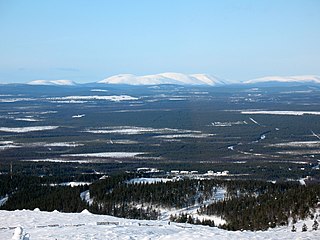
Levi is a fell located in Finnish Lapland, and the largest ski resort in Finland. The resort is located in the village of Sirkka, Kittilä municipality and is served by Kittilä Airport and Kolari railway station. At a latitude of 67.8° north, it is located approximately 170 km (110 mi) north of the Arctic Circle.

Ski cross is a skiing competition which incorporates terrain features traditionally found in freestyle skiing with courses which include big-air jumps and high-banked turns. In spite of the fact that it is a timed racing event, it is often considered a type of freestyle skiing. What sets ski cross apart from other alpine skiing disciplines is that it involves more than one skier racing down the course. Any intentional contact with other competitors like grabbing or any other forms of contact meant to give the competitor an advantage leads to disqualification.

Roller skiing is an off-snow equivalent to cross-country skiing. Roller skis have wheels on their ends and are used on a hard surface, to emulate cross-country skiing. The skiing techniques used are very similar to techniques used in cross-country skiing on snow.

Snow grooming is the process of manipulating snow for recreational uses with a tractor, snowmobile, piste caterpillar, truck or snowcat towing specialized equipment. The process is used to maintain ski hills, cross-country ski trails and snowmobile trails by grooming the snow on them. A variation of the technique is used to construct snow runways in Antarctica.

The U.S. Ski Team, operating under the auspices of U.S. Ski & Snowboard, develops and supports men's and women's athletes in the sports of alpine skiing, freestyle skiing, cross-country, ski jumping, and Nordic combined. Since 1974 the team and association have been headquartered in Park City, Utah.

Paralympic cross-country skiing is an adaptation of cross-country skiing for athletes with disabilities. Paralympic cross-country skiing is one of two Nordic skiing disciplines in the Winter Paralympic Games; the other is biathlon. Competition is governed by the International Paralympic Committee (IPC).

Rukatunturi is a 492 metres (1,614 ft) high fell and a ski resort in Kuusamo, Finland. Apart from downhill skiing, there are over 500 km of cross-country skiing tracks. Also snowmobiles can be rented to enjoy some of the area's 600 km of snowmobile routes. Ruka is also the southern end of the Karhunkierros hiking trail. The total of trails in Ruka and Kuusamo area is: 160 km of hiking trails, 605 km of biking routes, 350 km of classified paddling routes and 100 km of boating routes.
Mont-Sainte-Anne is a ski resort in eastern Canada, located in the town of Beaupré, Quebec, about 40 km (25 mi) northeast of Quebec City. The mountain is part of the Laurentian mountain chain and has a summit elevation of 800 m (2,625 ft) above sea level with a vertical drop of 625 m (2,051 ft).
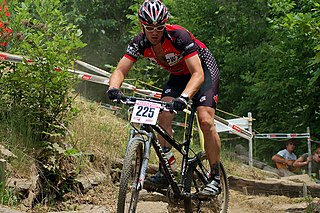
Hardwood Ski and Bike is located in Oro-Medonte Township in Ontario’s Lake Country region about one hour north of Toronto, Ontario. The facility is a family oriented cross country skiing, snowshoeing, mountain biking and outdoor recreation area.

Competitive cross-country skiing encompasses a variety of race formats and course lengths. Rules of cross-country skiing are sanctioned by the International Ski Federation and by various national organizations. International competitions include the FIS Nordic World Ski Championships, the FIS Cross-Country World Cup, and at the Winter Olympic Games. Such races occur over homologated, groomed courses designed to support classic (in-track) and freestyle events, where the skiers may employ skate skiing. It also encompasses cross-country ski marathon events, sanctioned by the Worldloppet Ski Federation, and cross-country ski orienteering events, sanctioned by the International Orienteering Federation. Related forms of competition are biathlon, where competitors race on cross-country skis and stop to shoot at targets with rifles, and paralympic cross-country skiing that allows athletes with disabilities to compete at cross-country skiing with adaptive equipment.
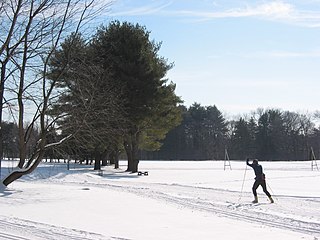
Weston Ski Track is a cross-country ski and snowshoeing area located in Weston, Massachusetts. The facility is managed by the Massachusetts Department of Conservation and Recreation and is situated along the Charles River, approximately 13 miles west of downtown Boston, Massachusetts.
This glossary of skiing and snowboarding terms is a list of definitions of terms and jargon used in skiing, snowboarding, and related winter sports.

The skating technique is a style of cross-country skiing in which the leg kick is made using the skate step. This style has been established as a revolutionary development of cross-country skiing since the mid-1980s and allows faster movement compared to the classic style. Since 1985, international competitions have been held separately in the classic and free technique, with the skating technique being used in free technique competitions.

